
Newton Lower Falls is one of the thirteen villages within the city of Newton in Middlesex County, Massachusetts, United States. The commercial area extends across the Charles River into Wellesley, where it is known as Wellesley Lower Falls, where a majority of the retail businesses are located.
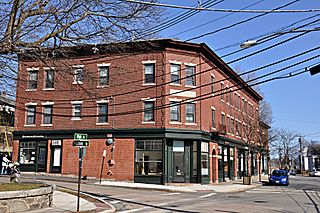
Newton Upper Falls is one of the thirteen villages within the city of Newton in Massachusetts, United States. The village is listed as the Newton Upper Falls Historic District on the National Register of Historic Places.
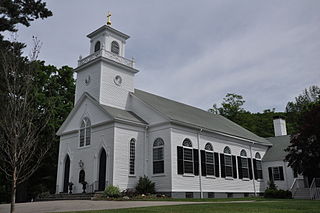
St. Mary's Episcopal Church and Cemetery is a historic church and cemetery at 258 Concord Street, in the village of Newton Lower Falls, Massachusetts, United States. St. Mary's Parish was formed in 1811. The church, built in 1813–14 and restyled in 1838, is the oldest church in Newton, and is a fine example of Gothic Revival/Federal style architecture. The cemetery, which dates from 1812, is the oldest non-government-owned cemetery in Newton. The property was listed on the National Register of Historic Places in 1980.

The Crane and Company Old Stone Mill Rag Room is one of the oldest surviving buildings of Crane & Co., one of the oldest papermaking businesses in Berkshire County, Massachusetts. It is located in southwestern Dalton, on a site where paper has been manufactured since the early 19th century. The building, originally used for processing rags, has housed the Crane Museum of Papermaking since 1930, and was designated a National Historic Landmark in 1983.

The Cranesville Historic District is a historic district in Dalton, Massachusetts, centered on the business and residential properties associated with the papermaker Crane and Company. The district, centered on Main Street west of the town civic center, was added to the National Register of Historic Places in 2005.

The Rising Paper Mill is a historic factory at 295 Park Street North, in the Housatonic village of Great Barrington, Massachusetts. Built in 1873 for H.D. Cone, it is one of the best-preserved examples of period mill architecture in Berkshire County. The complex was listed on the National Register of Historic Places in 1975. In 2008, the facility was purchased by Hazen Paper, which announced plans to manufacture multi-ply laminated paper for packaging.
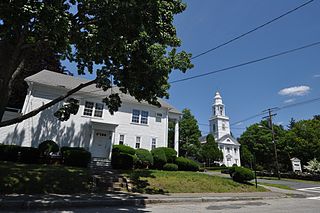
Church Street Historic District is a historic district roughly on Church Street between Park Ave. and Highland St. in Ware, Massachusetts. This mainly residential area includes some of Ware's finest late 19th century houses and a well-preserved collection of Greek Revival houses. The area was developed primarily in response to the growth of industry to the south. The district was listed on the National Register of Historic Places in 1983.

The Ware Millyard Historic District encompasses a 19th-century mill complex and industrial mill village in the town of Ware, Massachusetts. It is roughly bounded by South Street, the Ware River, Upper Dam Complex, Park Street, Otis Avenue and Church Street. The area includes surviving mill buildings, the oldest of which date to the 1840s, and a collection of tenement-style housing built for the millworkers, built between 1845 and the 1880s.

Otis Company Mill No. 1 is a historic mill on E. Main Street in Ware, Massachusetts, United States. Built in 1845, it is one of the best-preserved stone mills in western Massachusetts, and a rare surviving example of a large mill from the pre-turbine phase of industrialization. The building was listed on the National Register of Historic Places in 1982. It was further listed as a contributing property to the Ware Millyard Historic District in 1986.

The North Canal Historic District of Lawrence, Massachusetts, encompasses the historic industrial heart of the city. It is centered on the North Canal and the Great Stone Dam, which provided the waterpower for its many mill complexes. The canal was listed on the National Register of Historic Places in 1975, while the district was first listed in 1984, and then expanded slightly in 2009.

The Spicket Falls Historic District encompasses the historic industrial and commercial heart of Methuen, Massachusetts, and one of the lower Merrimack River's best-preserved 19th century mill complexes. It is centered on the falls of the Spicket River, from which the 19th century textile mills of Methuen derived their power. The historic district, listed on the National Register of Historic Places in 1984, includes commercial and civic buildings in and near Gaunt Square, the heart of the city, and along both sides of the Spicket River between Gaunt Square and the Boston and Maine Railroad tracks south of the river. It abuts the residential Pleasant-High Historic District, which lies to its east.

The William Curtis House is a historic house located at 2330 Washington Street in the Newton Lower Falls village of Newton, Massachusetts.

The Saco–Pettee Machine Shops is a historic factory complex at 156 Oak Street in the Newton Upper Falls area of Newton, Massachusetts. Although the area has an industrial history dating to the early 19th century, the oldest buildings in this complex, consisting of about thirteen brick buildings, were built in 1892. The property, a major economic force in the development of Newton Upper Falls, was listed on the National Register of Historic Places in 1986. It was home to Clark's N.A., the North American home base to Clark's Shoes, makers of fine footwear, until they relocated to Waltham Ma. in October 2016.
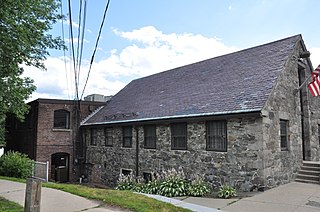
The Ware Paper Mill is a historic mill building at 2276 Washington Street in Newton, Massachusetts. Built in 1790, it is a remnant of the first paper mill to be built on the banks of the Charles River. The 1+1⁄2-story stone building was built by John Ware, a veteran of the American Revolutionary War, and was in use for paper production until 1938. A brick addition was added to the rear of the building in the 19th century; its interior was effectively stripped in the 1973.

The Lower Main Street Historic District of Lee, Massachusetts encompasses the historic center of the town. It is centered on the junction of Main and Park Streets, where the center of the town was laid out when it was established in 1760. Although a meeting house was erected on this site, that structure was torn down, and the space was converted into a town common, a function it continues to serve today. The district also includes a portion of the business district, running along Main Street. The district was listed on the National Register of Historic Places in 1976.

The Lisbon Inn, formerly The Moulton, is a historic former hotel building on United States Route 302 in Lisbon, New Hampshire. Located at the southern end of Lisbon's central business district, the 1901 three story wood-frame building is an imposing presence, with Queen Anne-style pyramidal roof turrets at the corners of the main facade. The front of the building has two stories of porches with Colonial Revival styling.

The Busiel-Seeburg Mill is a historic mill building in Laconia, New Hampshire, since converted into an office building known as 1 Mill Plaza. This 3-1/2 story brick structure achieved its present configuration in stages, beginning in 1853, and successively altered and expanded through the rest of the 19th century. The business, established by John W. Busiel in 1846, manufactured knitted hosiery, and was one of the first producers of knitwear to use circular knitting machines invented by Aiken and Peppers. The building was listed on the National Register of Historic Places in 1971.
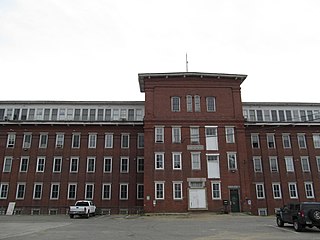
The Salmon Falls Mill Historic District encompasses a historic mill complex on Front Street in Rollinsford, New Hampshire. The complex includes four major structures and seven smaller ones, on about 14 acres (5.7 ha) of land along the Salmon Falls River. They were built between about 1840 and the mid-1860s, and have an unusual architectural unity, for additions made to the buildings were done with attention to matching design elements from the existing structures. The Number 2 Mill, built in 1848, was an early location where a turbine was used instead of a waterwheel to provide power to the mill machinery. The district was listed on the National Register of Historic Places in 1980.
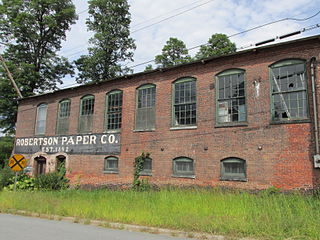
The Robertson Paper Company Complex was a historic industrial facility on Island Street in Bellows Falls, Vermont. It consisted of a collection of mostly-interconnected factory and related buildings, built between c. 1890 and c. 1960 by various paper-related companies. It was occupied and enlarged by the Robertson Paper Company between 1907 and its failure in 1987, at which time it was the longest-lived paper company in the state. The complex was listed on the National Register of Historic Places in 1990. It was demolished in 2018-19 as a Brownfields Economic Revitalization Alliance (BERA) project, with federal, state, and local funding.

The Moore and Thompson Paper Mill Complex is a major late 19th-century industrial site off Bridge Street in Bellows Falls, Vermont. It is the largest surviving mill complex from the village's industrial heyday, and is one of the largest of the period in the state. It was listed on the National Register of Historic Places in 1984.
























